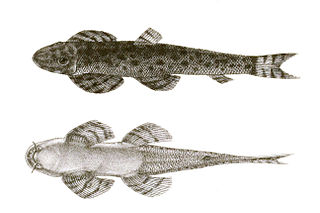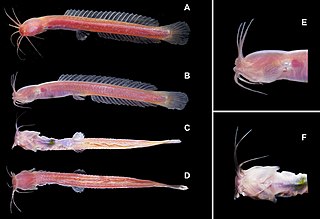
Cobitidae, also known as the True loaches, is a family of Old World freshwater fish. They occur throughout Eurasia and in Morocco, and inhabit riverine ecosystems. Today, most "loaches" are placed in other families. The family includes about 260 described species. New species are being described regularly.

Heinrich Kuhl was a German naturalist and zoologist.

Rasbora is a genus of fish in the family Cyprinidae. They are native to freshwater habitats in South and Southeast Asia, as well as southeast China. A single species, R. gerlachi, is only known from an old specimen that reputedly originated from Africa (Cameroon), but this locality is considered doubtful. They are small, up to 17 cm (6.7 in) long, although most species do not surpass 10 cm (4 in) and many have a dark horizontal stripe.

Indoreonectes is a genus of stone loaches native to the Western Ghats in India.

Schistura is a genus of fish in the stone loach family Nemacheilidae native to the streams and rivers of the southern and eastern Asia. Some of these species are troglobitic.
Amblyceps is a genus of fish in the family Amblycipitidae. The genera Amblyceps and Liobagrus are sister group pair that is, in turn, sister to Xiurenbagrus. These species are easily distinguished by the presence of pinnate processes along with the median caudal-fin rays, a prominent cup-like skin flap above the base of the pectoral spine, and the adipose fin largely separate from the caudal fin. In most species the caudal fin is deeply forked; A. apangi and A. murraystuarti differ in having their caudal fin truncate. Amblyceps species may reach about 100 millimetres (3.94 in) SL.
Pangio anguillaris is a species of loach found in still and slow-moving freshwater in Indochina, Malay Peninsula, Sumatra, and Borneo.

Cavefish or cave fish is a generic term for fresh and brackish water fish adapted to life in caves and other underground habitats. Related terms are subterranean fish, troglomorphic fish, troglobitic fish, stygobitic fish, phreatic fish and hypogean fish.

Balitora is a genus of fish in the family Balitoridae endemic to Asia.

Pangio semicincta, the half-banded kuhli loach, is a species of cobitid loach in the genus Pangio found in the Malay Peninsula, Borneo, and Sumatra. It is a very popular fish in the aquarium trade, however, it is often confused for and mislabeled as Pangio kuhlii, a slightly larger-bodied fish, which is rarely found in the aquarium trade due to it being endemic to Java, Indonesia, where field-collection for the fish trade is a rare occurrence.
The true Kuhli loach, occasionally referred to as eel loach, is a small eel-like freshwater fish belonging to the loach family (Cobitidae). They originate from the island of Java in Indonesia. This snake-like creature is very slender and nocturnal.

Loaches are fish of the superfamily Cobitoidea. They are freshwater, benthic (bottom-dwelling) fish found in rivers and creeks throughout Eurasia and northern Africa. Loaches are among the most diverse groups of fish; the 1249 known species of Cobitoidea comprise about 107 genera divided among 9 families.

Pethia is a genus of small freshwater fish in the family Cyprinidae native to South Asia, East Asia and Mainland Southeast Asia. Some species are commonly seen in the aquarium trade. The name Pethia is derived from the Sinhalese "pethia", a generic word used to describe any of several small species of cyprinid fishes. Most members of this genus were included in Puntius, until it was revised in 2012.

Badis is a genus of freshwater fish in the family Badidae found in South Asia, Southeast Asia and China. These species have a sharp spine on the opercle, soft and spinous parts of the dorsal fin contiguous, three spines in the anal fin, tubed pores in the lateral line, villiform teeth and a rounded caudal fin. In addition, they differ from the related genus Dario by being larger and displaying more involved parental care.

Rajeev Raghavan is a fisheries scientist and aquatic conservation biologist known for his work on the freshwater fishes of the Indian subcontinent. Rajeev is currently an Assistant Professor at the Kerala University of Fisheries and Ocean Studies, Kochi, India, the South Asia Chair of the IUCN’s Freshwater Fish Specialist Group., and the IUCN Freshwater Fish Red List Authority Coordinator for Asia and Oceania.

The Anabantiformes, collectively known as labyrinth fish, are an order of air-breathing freshwater ray-finned fish with two suborders, five families and having at least 207 species. In addition, some authorities expand the order to include the suborder Nandoidei, which includes three families - the Nandidae, Badidae and Pristolepididae - that appear to be closely related to the Anabantiformes. The order, and these three related families, are part of a monophyletic clade which is a sister clade to the Ovalentaria, the other orders in the clade being Synbranchiformes, Carangiformes, Istiophoriformes and Pleuronectiformes. This clade is sometimes referred to as the Carangaria but is left unnamed and unranked in Fishes of the World. This group of fish are found in Asia and Africa, with some species introduced in United States of America.
Aenigmachanna gollum, the Gollum snakehead, is a species of aquifer-dwelling dragon snakehead fish that is endemic to the Indian state of Kerala.
Aenigmachanna is a genus of ray-finned fish in the order Ananbantiformes. It is the only genus in the family Aenigmachannidae, or dragon snakeheads. It contains two species, both of which are largely restricted to subterranean habitats in southwestern India, namely in the Western Ghats foothills in the state of Kerala.

Horaglanis populi is a species of airbreathing catfish endemic to India, mainly in wells and underground water channels around Pathanamthitta District, Kerala. It lacks pigmentation and eyes, like other cavefish, Like other species of similar catfishes found in Kerala, it is also obtained from laterite wells.. The Horaglanis populi has an elongated body that comes with a round cross-section anteriorly which also comes with a large head that excludes eyes. The head of the Horaglanis populi has a wide mouth a truncated snout and four pairs of barbels which are two mandibular, one nasal barbel pair, and one maxillary.















